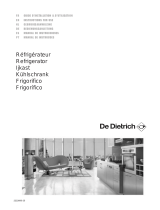19
En cas dÕanomalie de fonctionnement, reportez-
vous ˆ la rubrique ÒEN CAS DÕANOMALIE DE
FONCTIONNEMENTÓ. Si malgrŽ toutes les
vŽrifications, une intervention sÕav•re nŽcessaire, le
vendeur de votre appareil est le premier habilitŽ ˆ
intervenir. A dŽfaut (dŽmŽnagement de votre part,
fermeture du magasin o• vous avez effectuŽ
lÕachat...), veuillez consulter lÕAssistance
Consommateurs qui vous communiquera alors
lÕadresse dÕun Service Apr•s-Vente.
En cas dÕintervention sur votre appareil, exigez
du service apr•s-vente Ies pi•ces de rechange
certifiŽes Constructeur
Plaque signalŽtique
En appelant un Service Apr•s Vente, indiquez-lui le
mod•le, le numŽro de produit et le numŽro de sŽrie
de lÕappareil. Ces indications figurent sur la plaque
signalŽtique situŽe sur votre appareil.
SERVICE APRES-VENTE
POUR LES APPAREILS COMMERCIALISES EN FRANCE
GARANTIE
ConformŽment ˆ la LŽgislation en vigueur, votre Vendeur
est tenu, lors de lÕacte dÕachat de votre appareil, de vous
communiquer par Žcrit les conditions de garantie et sa
mise en Ïuvre appliquŽes sur celui-ci.
Sous son enti•re initiative et responsabilitŽ, votre Vendeur
rŽpondra ˆ toutes vos questions concernant lÕachat de
votre appareil et les garanties qui y sont attachŽes.
NÕhŽsitez pas ˆ le contacter.
22
Printed on recycled paper
WARNINGS
It is most important that this instruction book should be retained with the appliance for future
reference. Should the appliance be sold or transferred to another owner, or should you move house
and leave the appliance, always ensure that the book is supplied with the appliance in order that the
new owner can be acquainted with the functioning of the appliance and the relevant warnings.
If this appliance featuring magnetic door seals is to replace an older appliance having a spring lock
(latch) on the door or lid, be sure to make that spring lock unusable before you discard the old
appliance. This will prevent it from becoming a death-trap for a child.
These warnings are provided in the interest of safety. You must read them carefully before installing or
using the appliance.
General Safety
¥ This appliance is designed to be operated by
adults. Children should not be allowed to tamper
with the controls or play with the product.
¥ It is dangerous to alter the specifications or
modify this product in any way.
¥ Before any cleaning or maintenance work is carried
out, be sure to switch off and unplug the appliance.
¥ This appliance is heavy. Care should be taken
when moving it
¥ Ice lollies can cause frost burns if consumed
straight from the appliance.
¥ Take utmost care when handling your
appliance so as not to cause any damages to
the cooling unit with consequent possible
fluid leakages.
¥ The appliance must not be located close to
radiators or gas cookers.
¥ Avoid prolonged exposure of the appliance to
direct sunlight.
¥ There must be adequate ventilation round the
back of the appliance and any damage to the
refrigerant circuit must be avoided.
¥ For freezers only (except built-in models): an
ideal location is the cellar or basement.
¥ Do not use other electrical appliances (such
as ice cream makers) inside of refrigerating
appliances.
Service/Repair
¥ Any electrical work required to install this
appliance should be carried out by a qualified
electrician or competent person
¥ This product should be serviced by an authorized
Service Centre, and only genuine spare parts
should be used.
¥ Under no circumstances should you attempt to
repair the appliance yourself. Repairs carried out
by inexperienced persons may cause injury or
more serious malfunctioning. Refer to your local
Service Centre, and always insist on genuine
spare parts.
¥ This appliance contains hydrocarbons in its
cooling unit; maintenance and recharging must
therefore only be carried out by authorized
technicians.
Use
¥ The domestic refrigerators and freezers are
designed to be used specifically for the storage
of edible foodstuffs only.
¥ Best performance is obtained with ambient
temperature between +18¡C and +43¡C (class
T); +18¡C and +38¡C (class ST); +16¡C and
+32¡C (class N); +10¡C and +32¡C (class SN).
The class of your appliance is shown on its rating
plate.
Warning: when the ambient temperature is not
included within the range indicated for the class
of this appliance, the following instructions must
be observed: when the ambient temperature
drops below the minimum level, the storage
temperature in the freezer compartment cannot
be guaranteed; therefore it is advisable to use
the food stored as soon as possible.
¥ Frozen food must not be re-frozen once it has
been thawed out.
¥ ManufacturersÕ storage recommendations should
be strictly adhered to. Refer to relevant
instructions.
¥ The inner lining of the appliance consists of
channels through which the refrigerant passes. If
these should be punctured this would damage the
appliance beyond repair and cause food loss. DO
NOT USE SHARP INSTRUMENTS to scrape off
frost or ice. Frost may be removed by using the
scraper provided. Under no circumstances should
solid ice be forced off the liner. Solid ice should be
allowed to thaw when defrosting the appliance.
¥ Do not place carbonated or fizzy drinks in the
freezer as it creates pressure on the container,
which may cause it to explode, resulting in
damage to the appliance.













